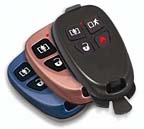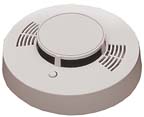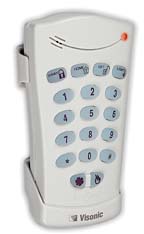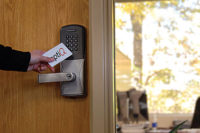
Photo courtesy of DSC

Photo courtesy of GE Infrastructure, Security
All Action Alarm Inc., South Huntington, N.Y., which specializes in residential systems, uses wireless for 98 percent of its installations.
“People don’t want us there for two or three days making a mess,†explains Stephen Mele, All Action Alarm’s owner. “We can do a very large house in one day with two or three people.â€
Mele also is using more wireless because changes in interior decorating styles have driven the company in that direction. “Years ago, people had carpet and you could hide the wires under the carpet,†he remembers. “But today, nobody puts carpet down, and you can’t hide wires on a wood floor.â€
However in most cases, All Action Alarm continues to hardwire door contacts and motion detectors. Because such sensors are tripped frequently, their battery life can be shorter than for sensors that are infrequently activated, such as those on windows. For Mele, as for many alarm dealers, it is important that a wireless alarm panel also is able to support several hardwired zones.

Photo courtesy of Napco Security Group
Two-way on the Rise
Manufacturers continue to develop innovative ways of improving the performance of their wireless alarm systems. Linear has fine-tuned its system so that it can “better receive signals in x, y and z coordinates,†explains Chuck Stevens, vice president of electronic systems for the company. “The second floor, third floor and basement matter, too.â€Inovonics recently introduced the third generation of its Echostream system. The new system, which operates at 900 MHz, supports more points than earlier systems and, according to Inovonics CEO Andy Drenick, provides improved range, higher data rates and increased stability across a range of temperatures.
“The third-generation product takes advantage of semiconductor advances and creates a technology platform that allows multiple applications – such as duress, perimeter protection and intrusion – in the same facility,†Drenick notes.
Later this year, the Inovonics system also will support two-way communications, enabling customers to use multifunction keypads and other two-way devices and to control sensors via programming. For example, motion detectors could be programmed to turn off automatically during daytime.
Among the other manufacturers that are beginning to support two-way communications are Visonic and GE Infrastructure, Security. Both companies offer two-way wireless keypads and some other unique two-way sensors, as well. Visonic, for example, has a remote wireless siren. “The panel talks to it and tells it to play an alarm noise or fire noise,†explains Scott Jensen, Visonic technical manager.
Meanwhile, GE has introduced a two-way wireless heating and cooling control. Although the idea of interfacing a thermostat with an alarm panel always has been appealing, it usually is impractical for wired systems because, as Richard Buus, GE’s director of product management, explains, the thermostat typically is installed on an interior wall, which can be difficult to wire. In comparison, Buus maintains, GE’s two-way wireless alternative is easy to install.
Installation challenges also drove the development of GE’s new wireless telephone interface module, which is particularly useful with systems that use an integrated panel and keypad. The new interface can be installed near the telco demarcation point to provide line seizure and wireless communications with the panel.
“It takes away the smash-and-grab scenario,†Buus declares, referring to situations where an intruder pulls an integrated panel and keypad off the wall. When the home is entered, a 45-second delay starts. If the interface module does not hear from the panel within that time, it assumes a possible smash-and-grab scenario is underway and reports it.
Another new GE product, which could benefit dealers whether or not they use two-way communications, is what Buus claims is the industry’s first wireless, 190-degree rate-of-rise sensor.

Photo courtesy of Visonic
Testing Trends
Wireless key fobs have become increasingly popular in recent years, as end users have learned to appreciate this convenient method of arming and disarming their systems.Borrowing an idea from the cell phone business, DSC recently introduced designer cases to add to the user appeal of its key fobs.
Manufacturers continue to strive to make wireless systems easier to install, as well. System testing, in particular, is an area of recent innovation.
For example, Napco provides a signal strength indicator at the keypad. Linear and DSC also have signal strength indicators.

Photo courtesy of Visonic.
The Fire Frontier
The next frontier for wireless development may be in the area of fire protection.“We’re putting more safety checks into our devices,†explains Angelo Arcaria, manager of electronics engineering for Edwards Signaling. “In the next five years, you’ll see a lot of manufacturers on agency boards pushing wireless, and the industry will standardize on some particular protocol.â€
Battery life is still a concern with fire systems, but advances are being made on that front.

Photo courtesy of Inovonics Wireless Corp.
Sidebar: Wireless May Sell More ‘Prewires’
Although it might seem like a contradiction in terms, alarm dealers increasingly are using wireless for prewire installations. The idea of using wireless alarm systems in new construction applications might have seemed crazy just a few years ago. But more and more dealers who contract with builders to pre-wire new homes are finding benefits in using wireless.One such company is Sanders Security Inc., Dothan, Ala. Instead of simply installing the alarm system wiring, then later attempting to persuade home buyers to purchase an alarm system, Sanders includes a basic system as part of the initial installation.
“Compared to what we used to charge for prewire, for just a bit more we can offer a working alarm system,†explains Greg Anderson, Sanders’ residential installation manager. “When you go back to solicit monitoring, it’s a whole lot easier to sell monitoring when the panel is already there.â€
Sanders’ strategy also helps prevent competitive alarm companies from winning the business. With the old approach involving prewiring only, “Anybody and his brother could put an alarm system in,†Anderson concedes.
Generally, Sanders uses a panel that supports 16 wireless and six wired zones. The company typically wires the keypad and the motion detector. The basic system does not include window protection, but if the customer wants that, the company installs wireless transmitters for that purpose.

